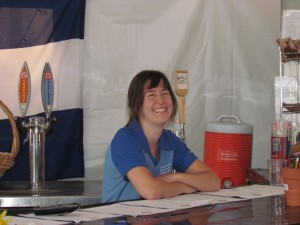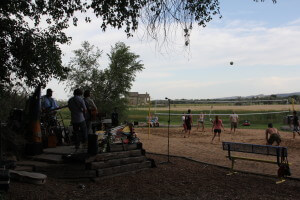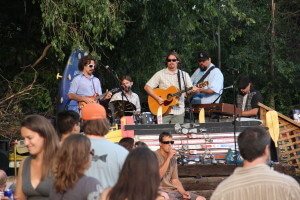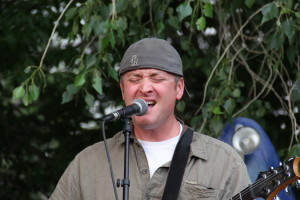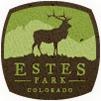COVID-19 Announcement

Update June 9, 2020
We have always prided ourselves in the cleaning of our gear. Since opening in 2001, we have sanitized the gear daily, and we are taking additional measures to help with COVID-19 and protect you and our employees this season.
Along with sanitizing PFDs, helmets, and wetsuits, we have also started sanitizing paddles between trips. We created a sanitation team, carrying backpack spray systems (think Ghost Busters, or Ghost Bleachers as we’ve been calling them) to take care of us all over the place. All employees are temperature and symptom checked daily. Guests are asked to stay home if they are symptomatic (fever, flu-like symptoms, cough, shortness of breath, etc.). The complimentary fleece jackets normally provided are very difficult for us to dry in time for the next needed trip, so this season we ask that you bring your own fleece jacket, which will get wet.
Around the facilities, we’re also practicing extra precaution and following state and county guidelines. Our 12-acre site is mostly outdoors. Check-in for rafting is under a large tent with lots of ventilation. Bathrooms are scattered throughout the property, and are cleaned and sanitized often. The busses are running at 50% capacity with the windows down, even during inclement weather, to increase ventilation. The vehicles are sanitized after each trip. Boats will be limited to two households per boat.
When you arrive at the Mountain Whitewater site:
- Masks are required when you enter, walk around and while on the bus, but not on the rafts. After your trip, you may sit in one of our 50 spaced out tables and enjoy a beer with your group without masks.
- Maintain social distancing from other groups by at least six feet.
- Fill and bring a reusable water bottle to share between your group while on the raft. Guides will attach personal water bottles to the raft using a caribiner clip, so check that your bottle has a loop or hook.
As you walk around our property to sit and wait, enjoy a beer or play a game of corn hole, you will see rocks with red on one side and green on the other. GREEN means that item has been sanitized and is ready to go. Please flip the rock over to RED once you use it so that our backpack spraying sanitizing team can take care of it.
Thanks for continuing to support local, family-owned business, and we look forward to seeing you soon.
Update April 29, 2020
Due to government restrictions and social distancing guidelines, the start of the 2020 season has been postponed to May 30. Please check back for future updates or call 970-419-0917 for additional information.
Update April 14, 2020
Standard Cleaning Policy
The following details the standard cleaning procedures at Mountain Whitewater & Paddler’s Pub. The health and safety of both staff and guests is a top priority. The policy is based on recommendations from the Colorado Department of Public Health and Environment and The Centers for Disease Control and Prevention. The following recommendations from the Colorado Department of Public Health and Environment have been adopted by Mountain Whitewater & Paddler’s Pub:
Based on what is currently known about the virus, spread from person-to-person happens most frequently among close contacts (within about 6 feet). This type of transmission occurs via respiratory droplets. Transmission of COVID-19 to persons from surfaces contaminated with the virus has not been documented. Current evidence suggests that COVID-19 may remain viable for hours to days on surfaces made from a variety of materials. Cleaning of visibly dirty and high touch surfaces followed by disinfection is a best practice measure for prevention of COVID-19 and other viral respiratory illnesses in households and community settings.
- Cleaning refers to the removal of germs, dirt, and impurities from surfaces. Cleaning does not kill germs, but by removing them, it lowers their numbers and the risk of spreading infection.
- Disinfecting refers to using chemicals to kill germs on surfaces. This process does not necessarily clean dirty surfaces or remove germs, but by killing germs on a surface after cleaning, it can further lower the risk of spreading infection.
How to Clean and Disinfect Surfaces
- Cleaning and disinfection after persons suspected/confirmed to have COVID-19 have been in the facility
- It is recommended to close off areas used by the ill persons and wait as long as practical before beginning cleaning and disinfection to minimize potential for exposure to respiratory droplets. Open outside doors and windows to increase air circulation in the area. Restrict access for two hours after the sick person has left. If possible, wait up to 24 hours before beginning cleaning and disinfection.
- Clean and disinfect all areas (e.g., offices, bathrooms, and common areas) used by the ill persons, focusing especially on frequently touched surfaces. Continue to follow all cleaning and disinfecting recommendations provided below.
- Wear disposable gloves when cleaning and disinfecting surfaces. Gloves should be discarded after each cleaning. If reusable gloves are used, those gloves should be dedicated for cleaning and disinfection of surfaces for COVID-19 and should not be used for other purposes. Clean hands immediately after gloves are removed.
- If surfaces are dirty, they should be cleaned using a detergent or soap and water prior to disinfection.
- For disinfection, diluted household bleach solutions, alcohol solutions with at least 70% alcohol, and most common EPA-registered household disinfectants should be effective. Consult the manufacturer’s instructions for cleaning and disinfection products used.
- Diluted household bleach solutions can be used if appropriate for the surface. Check the label on the bleach container to be sure it provides claims about disinfecting and instructions for mixing. Follow manufacturer’s instructions for mixing, application and proper ventilation. Avoid using bottles of bleach that you think may be older than one year or are past their expiration date as marked on the bottle. Never mix household bleach with ammonia or any other cleanser. Unexpired household bleach will be effective against coronaviruses when properly diluted.
Daily Cleaning Checklist for Mountain Whitewater & Paddler’s Pub
**This policy will be updated as more information about the disease becomes available and new government and social restrictions are mandated.**
Office:
- Disinfect all “high-touch” surfaces in office desk area including computer keyboards, mouse, iPads, square stands, credit card readers, printers, copier, file cabinet handles, retail display handles once every two hours.
- Clean, then disinfect the following surfaces in the tent twice per day after each trip leaves: retail displays, office desk, photo station, bar, beer coolers, big table, canoe table, canoe pew, office and pub floors, water cooler, tent center poles.
- Disinfect all of the following areas in the office storage container twice per day: container handles, beer coolers, lockers, file cabinets, cash box, cash drawers.
- Make sure to wear disposable gloves when touching retail items when stocking and wash hand after.
- Make sure guests use hand sanitizer before shopping and touching any retail items and displays.
- Disinfect TV remotes twice per day.
- Clean, then disinfect the following surfaces in the main house twice per day after each trip leaves: door handles, bathroom surfaces, toilets, atm, brochure displays, light switches.
- Clean, then disinfect the following surfaces in the main house once per day: desk, floors, carpet.
- Make sure to wear disposable gloves and clean surfaces after using items or touching surfaces in the upstairs kitchen area. Bathroom surfaces in upstairs galley need to be sanitized once per day.
- All rental equipment must be disinfected after each return.
Utility Person:
- Clean and disinfect all wrought iron tables, chairs, picknick tables, benches once per day.
- Hose off playground equipment once per day with soap and water once per day.
- Disinfect all stage and music equipment after use by bands.
- Hose-off all yard games once per day with disinfectant solution.
- Clean and disinfect gas grills, heaters, fire table once per day.
- Hose off all trash and recycle bins once per week with soap and water.
- Clean and disinfect tent walls once per week.
Bartenders:
- Disinfect all “high-touch” surfaces in the bar area as often as possible, but at least once per hour: bar top, beer coolers, iPads, cash drawers, receipt printer, draft handles, water cooler, wine fridges, soda fridge, bar top games, beer lists.
- Clean and disinfect bar stools twice per shift.
- Clean and disinfect pub floor after each shift.
- Make sure to make a new bleach water solution to start each sift.
- Clean out inside of beer coolers and draft coolers twice per week.
- Make sure to disinfect tap locks and tap plugs before use on taps.
- Disinfect tavern heads once per shift.
- Disinfect handles and gauges on CO2 tanks once per shift.
Boat Barn (guides):
- Clean and disinfect all rafting equipment after each use. Rafting equipment will not be re-used for another trip without being disinfected. All equipment must completely soak in disinfecting solution and Sink the Stink until saturated. Equipment must air dry for at least 20 minutes before being put away.
- Clean and disinfect the following surfaces in the boat barn once per day: helmet counter, changing room stall handles and hooks, door handles, electric pump blowers and cord, light switches.
- Sweep floor and vacuum floors every other day.
- Guides must make sure to wash hands or use hand sanitizer after cleaning gear and before each trip.
Buses (Drivers):
- Disinfect all bus seats door handles at the end of each day.
- Disinfect driver cab area after each day including steering wheel, seat, switches, air brake knob, and any other surface used that day.
- Sweep out bus floor after each day.
March 24, 2020
At Mountain Whitewater, our employee and guest health and safety are a top priority. We are currently closely monitoring the changing situation in our State and Country concerning the COVID-19 virus outbreak. We will continue to monitor information released from the Centers for Disease Control and Prevention (CDC) and will follow recommended practices for a clean and healthy environment.
Mountain Whitewater prides itself on maintaining high quality, clean equipment and facilities and will continue to clean and disinfect all rafting equipment daily. Our everyday equipment cleaning process involves first soaking all equipment in a disinfectant solution followed by a soak in a deodorizing solution. The process makes sure we have clean equipment that does not stink. In addition to our normal, everyday process, we will take some additional steps as well.
- Increase the frequency of cleaning and disinfecting our busses.
- Increase the frequency of cleaning and disinfecting of office and pub facilities.
- Post additional signage to encourage effective hand washing and hand sanitizer use to stop the spread of germs and viruses.
- Communitcate to our employees and guests the CDC guidelines for reducing the spread of germs and viruses.
Mountain Whitewater and Paddler’s Pub are staying positive and planning on having a fantastic summer season in 2020. We are now taking reservations and plan to open normally on May 15. Please stay tuned for more announcements and thanks for the continued support. We hope for wellness for families and communities and know that the river will be there to heal our souls when this ordeal is over. See you on the river this summer!
Cancelation Policy: A full refund will be issued, less 10% reservation fee (6% goes to credit card fees, 4% helps pay our staff a living wage), if canceled with office staff 7 days or more before your trip. Any cancellation within one week of the trip date is non-refundable. Trip cancelation insurance is available but must be purchased at the time of booking for the entire group. Please ask our office staff if interested.
The Laughing Dog Food Truck at Mountain Whitewater

By Ben Costello, January 2020

We would like to introduce our friends The Laughing Dog Food Truck. Now OPEN FOR BUSINESS! Serving up all-beef hot dogs, the best chili cheese dogs ever, kraft dogs with spicy mustard, brats, hot polish sausages, their signature Diablo Sandwich and more. They always have a weekly rotating special and affordable pricing.
The Laughing Dog Food Truck will be available to feed the hungry guests at Mountain Whitewater & Paddler’s Pub every day during the 2020 rafting season. Nothing works up an appetite like an exciting whitewater rafting trip!
If you have questions or would like to book The Laughing Dog for an event, please call or email Kelly.
(970) 310-5590
kellykissell77@gmail.com
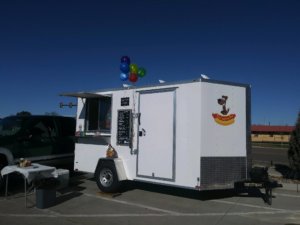
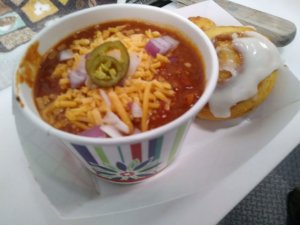


2019 Summer Music – End of Season Party
paddlers pub end 2019 poster small
Poudre Canyon Name History

by Ben Costello, January 2018
While doing some cleaning, I came across an old document and thought the information might be interesting to post. The information in the document was compiled by Stanley R. Case in June of 1992 for the Arapaho/Roosevelt National Forest folks. It outlines the name history of many sites in the Cache La Poudre River canyon. It reads as follows, enjoy!
ARROWHEAD LODGE
Named by C. Marion Brofford for a point across the Cache La Poudre River to the south which was once referred to as Arrowhead Point by early settlers.
ANSEL WATROUS CAMPGROUND
A cooperative agreement in 1918 between the city of Fort Collins and Roosevelt National Forest led to the creation of a mountain park in Poudre Canyon named for Ansel Watrous, the author of “Larimer County History- 1911”.
BALDWIN TUNNEL
This tunnel was holed through in the fall of 1916 and prior to this the road ended at Thompson’s Resort (Mishawaka). Travel to the upper reaches of the Poudre River was over Pingree Hill to Rustic.
BARNES MEADOW/RESERVOIR
Abraham LeFever, cattleman and homesteader of Indian Meadow Ranch, named this fro a relative, David Barnes. The reservoir was built in 1929 by the Mountain Plains Irrigation Company for July and August irrigation water for the Fort Collins-Greeley area.
BELLAIRE LAKE
In the 1880’s Jocelyn Bellairs homesteaded on South Lone Pine Creek, and in 1890 Malcolm Bellairs operated a ranch in the Weast Lake Area. The transfer of “e” for “s” was a typing error.
BENNETT CREEK
I.W. and E.J. Bennett were early sheepmen, ranchers, and community leaders in the Livermore area beginning in the late 1870’s.
BLUE LAKE
This Lake is located in the south end of the Rawahs, and was presumably named because of its color. The trailhead originally started on the west side of Chambers Lake, but is now located opposite the entrance of the Long Draw Reservoir Road.
BROWNS PARK and BROWNS PARK CAMPGROUND
During the mid 1920’s three boys, members of the Brown family, spent several winters camped while trapping in the beautiful little park on Jinks Creek. They did not build a cabin, and no further information is available as to their next destination.
CACHE LA POUDRE RIVER
Several events attempt to qualify as the historical basis for this river’s name. One concerns Major Stephen H. Long’s encampment on July 3, 1820 along the South Platte River near the entering points of three streams. Another in 1835 on July 18, was recorded during Colonel Henry Dodge’s march with a battalion of dragoons over Long’s same trail. As they rounded the great bend of the South Platte, they passed the mouth of the first stream and recorded it as the Cache de la Poudre. The guide was Captain John Gantt, a former army officer turned leader of free trappers who knew the country and called it by the mane. It’s meaning is “hide the powder”. Ansel Watrous recorded the date of the naming as 1836, but his date is disputed by Colonel Dodge’s record.
Several accounts related a trapper party carrying supplies to a rendezvous on the Green River in Wyoming getting caught in a snowstorm which forced them to bury (cache) supplies until they could return and retrieve them. There is also a story that William H. Ashley made a cache while trading in the area with the intention of retrieving the items when they resumed their journey to a rendezvous. The cache may have been left and dug up by the father of Antoine Janis mentioned by Watrous.
The date of the naming is not known, but trappers hid valuables by digging a small hole in the ground and then scooping out a chamber for storage. The hole was carefully filled in and concealed by replacing sod, disposing of excess dirt and tramping it down or even building a fire over it to hide it. The mane Cache la Poudre is probably a contracted form of “cachez la poudre” meaning “hide the powder”.
CAMERON PASS
Major General Robert A. Cameron, in the service of the Union from 1861 – 1865, and organizer of the Fort Collins, Colorado Agriculture Colony in 1872, was an important factor in the settlement of the Cache La Poudre Valley. On a trip to Chambers Lake, he and Dr. Lows discovered the pass through the Medicine Bow Mountains in North Park. Later the pass was named by the Union Pacific Engineering Department in memory of General Cameron.
CAMP LAKES
In the early days of settlement, a ditch was built to take water from these two lakes found in the Rawahs to the Skyline Ditch and to the Cache La Poudre River. Near the lakes a camp was erected for the ditch workers. Nothing today remains of the old cabins of this camp for which the lakes were named.
CASH MINE
This mine was originally called the Elkhorn Mine, which was located by John Zimmerman and his brother Mike in 1881. Mr. Zimmerman sold the mine to a brother-in-law in St. Louis who was with the Cash Mining Company. The old mine is located on the mountain across the road and to the east of the Poudre Canyon Chapel. It was later worked by a “hard-rock” miner named Roy O Conner and called the Cash Mine or O Conner Mine. After Mr. O Conner’s death, Ed Cox and Andie Longston filed on the claim and named it the Cash and Carry Mine. The claim was never patented, however, new claims have been registered in 1989 and 1990.
CHAMBERS LAKE
In 1858 Robert Chambers and his son, Robert Jr., set up a rapping camp near the lake. During an absence by his son, Indians attacked and killed the elder Chambers. Later in 1867 while the Union Pacific railroad was working on its route west of Cheyenne, Robert Jr. told a tie contractor about the plentiful timber on the upper Poudre River. A tie as established by the lake and the workers named the lake in honor of the slain trapper. A small dam was built at the lake to raise the water level under the first water decree in 1887. The first dam washed out on June 9, 1891, and has been rebuilt twice since. The lake is now partially owned and operated by Water Supply and Storage Company.
CLARK PEAK
The highest mountain in the Chambers Lake region takes its name from William Clark of the Lewis and Clark expedition. It’s Native American name was Elk Horn. Originally the peak was called Cameron for nearby Cameron Pass.
COLUMBINE
The prevalence of these flowers gave this settlement its name.
CRATER LAKE
This lake is one of twin lakes feeding a small tributary of the West Branch of the Laramie River. It was named by Red Vernon, a guide in the Rawahs, because to him it looked like a crater had formed in the high peaks.
CROWN POINT
Crown Point was a mining claim, but the origin of the name is unknown.
DADD GULCH
Named for an elderly Afro-American known as “Dad” who had a cabin in the gulch. The second “d” in the name is unaccounted for.
DUTCH GEORGE FLATS
The area at the junction of Elkhorn Creek with the Poudre River was once inhabited by an old trapper/hunter named George Neare, known as “Dutch”. He protected his hunting preserve, Elkhorn Creek Canyon, with a passion. Legend says his own loaded riffle fell down and shot him as he skinned a bear. Another legend says he was killed by a bear on this site in the late 1800’s. A still-growing apple tree marks the site of his cabin.
EGGERS
The summer post office, resort, and bridge was named for the Fred Eggers family, the original settlers of the site.
EGGERS SCHOOL
Originally located on the hill behind Eggers Post OFfice for which it was named, this school was a WPA project with construction in the early spring and summer of 1934. Logs were cut and hauled from the Chambers Lake area and layed up by WPA workers along with local residents. The school opened that fall and closed after the completion of the Poudre Canyon School in 1959. The old log school has been moved to a location just east of the Poudre Canyon School and may be converted into a museum.
FOR COLLINS MOUNTAIN PARK
A USFS campground taking its name from the city of Fort Collins.
GLENN ECHO (RESORT)
The land was purchased from Norman Fry by a Mr. Cooke, who built the first camp in 1920. It consisted of a small store, and across the road at the present Glen Echo site, several tent frames with wooden floors. The name comes from a spot just west of the site where one can hear voice echoes from across the canyon.
GLENDEVEY
Old Glendevey (accent on the last syllable) was originally named after Thomas H. Dovey who owned a ranch in the glen. It once served as a Post Office.
HOHNHOLTZ LAKE
The lakes were named after the E. and E. Honholz family because of their extensive holdings in the Slugh (?) and Grace Creek area in the Laramie River Valley. Their US land patents went back to 1904 and 1916-17.
HOME
The Home Post Office was first located in a small cabin at the Kinikinik Ranch with John R. Brown as postmaster. Brown had been a blacksmith for Old Camp Collins. About 1880 Brown applied for a post office under the name of “Mountain Home” but was told that there were too many Mountain Homes in the United States, so the name was shortened to Home. In 1896 after John Zimmerman built the Keystone Hotel, he was appointed postmaster of Home and the post office.
HOME MORAINE
This terminal moraine was the result of an episode of glaciation. The name was taken from the Home Post Office.
HOME MORAINE TRAILER PARK
Located in the general area of the Zimmerman Hotel and livery stables, it takes its name from the Home Moraine.
HOURGLASS RESERVOIR
Originally called the Big Beaver, this reservoir located up the Little South River is now named for its shape.
HULEATT (Hewlett’s) GULCH
Horace Huleatt settled in the gulch which bears his name, but not its spelling, in the late 1870’s. it is reported that an old Ute Trial followed the gulch, located nor of Columbine (Poudre) Park. Huleatt eventually moved on to California, and left a stone cabin in the gulch.
INDIAN MEADOWS
Early Euro-Americans coming into this area located on the Poudre River found Arapaho, Cheyenne, and Ute Indians camping, hinting, and fishing in the area.
INDIAN MEADOWS RESORT/STORE
Probably named for the meadow, but may have been a requirement when Guy Slenecker purchased the business rights from the Indian Meadows Corporation in 1925. he built and operated the camp until 1934 when the operation was taken over by Archie and Neva Langston. Neva is the daughter of Guy. It is not known when the name was changed to Indian Meadows Resort.
ISLAND LAKE
Found in the Rawahs, this lake was named by the Sholine family due to the jagged rock island that stands in the middle of the lake.
JOE WRIGHT CREEK
The creek that feeds Chambers Lake from the south was named for a beaver trapper that spent a winter collecting pelts along the stream in the 1800’s.
JOE WRIGHT RESERVOIR
The reservoir takes its name from the Creek. It was built in 1904 by foreman John McNabb and engineer William Rist working for a Mr. F.C. Crable. This was a part of the Michigan River Ditch system, and later purchased from them by the North Poudre Irrigation Company, now owned by the City of Fort Collins. Fort Collins has recently built a new dam to increase the reservoir capacity.
KELLY FLATS
A tie cutter named Jim Kelly, and a man named Jack Dunn, built a cabin on these flats.
KELLY FLATS CAMPGROUND
A USFS campground that took the name of the flats upon which it was constructed.
KINIKINIK
Named by Charles B. Andrews because of the abundance of the evergreen plant growing in the area. There is no explanation for the incorrect spelling on maps. The plant name is spelled kinnikinnick. Andrews was a prominent cattleman who invested in land on the Poudre River in the 1880’s to raise Shetland ponies and cattle for the eastern market. The cabin that housed the first Home Post Office was located on his land.
Over the years the ranch was called Shady Lane Ranch. The Shetland Ranch, the Cup Williams Ranch, and since the purchase by Clarance Bliss in 1941, the name Kinikinik has prevailed.
LAKE LOUISE (Bench)
This lake was named for Louise Sholine (Mrs. F.W. McWilliams), daughter of Mr. and Mrs. Louis Sholine, earliest ranch owners on the West Branch of the upper Laramie River. Today it is shown as Bench Lake on USFS maps.
LARAMIE RIVER
Jacques LaRamee (LaRamie), a French Canadian in the employment of the Northwest Fur Company came into the upper headwaters of the Missouri about 1819. In 1820, h with several other trappers trapped on the headwaters of the North Platte. Later that same year, LaRamee against the advice of the fellow trappers, decided to trap the Laramie River and its tributaries. The area was a battleground among several tribes of Native Americans, but LaRamee believed he would be safe because he was on friendly terms with most of the tribes. At the next rendezvous, LaRamee was missing. His friends organized a party to hunt for the trapper and in a few days found his cabin. Unfortunately, there are no confirmed reports that they located his body, but they did call the river Laramie’s River later shortened to Laramie River. his name with the different spelling has been given to several locations in the region.
LARAMIE-POUDRE TUNNEL
The tunnel connects the two rivers and transfers water from the Laramie River to the Poudre River. The plans were drawn up in 1907 and the tunnel completed in the fall.
LINK LAKES
This chain of lakes, located in the Rawah area on the eastern side of the Medicine Bow Mountains, was discovered by Willis A. Link in 1901.
LIVERMORE
Livermore is derived from a combination of the names of Adolphus Livernash and Stephen Moore, two of the area’s earliest permanent settlers. The name has been used for stage stops, a hotel, store, post office, school, and livery stable in the area over the years.
LOG CABIN
A name given to the hotel and post office built and operated by Mrs. Elizabeth St. Clair. Mrs. St. Clair originally homesteaded 320 acres on the site. It became an official U.S. Post Office in 1903. The original building caught fire and burned in November of 1931 but the post office was continued until 1941 when it was closed. Nothing remains on the site now except a historical marker that was dedicated August 6, 1983. The location is at the intersection of the Livermore and Red Feather Lakes Road and the Elkhorn Road to the Poudre River.
LONG DRAW RESERVOIR
The reservoir is located in Long Draw, above the northwest corner of Rocky Mountain National Park. The draw was named by early tie cutters that set up camp in the draw and maned it for its length, which ran from the top of Poudre Pass to the Big South of the Cache la Poudre River. The reservoir was built by Water Supply and Storage Company in 1931 to regulate water diverted from the Grand River Ditch.
The dam as recently expanded for additional storage, and at that time the company was required to include campground and picnic facilities to USPS specification, and a holding pond for fish. The agreement included turning the facilities over to the Roosevelt National Forest.
LULU CITY
Founded and platted by Benjamin Burnett in 1879 along the upper reaches of the Colorado River, then called the Grand River, this once bustling, but short-lived gold boom town lasted, but four years. Burnett named the site after one of his daughters, and his log building was the first constructed in the town, becoming the area store. For Several years the site grew and housed many miners and prospectors, but the gold ore was of such low quality the town was soon abandoned.
The decaying buildings were later removed after the establishment of Rocky Mountain National Park in 1915 and included the area within its boundaries. A historical marker has been placed at the site along the hiking trail int to the area.
LULU PASS
The old haul-road to Lulu City included the Log Cabin to Manhattan road west through the Bald Mountains and then followed what is now known as the Green Ridge Trail to Chambers Lake. The route then went on to Cameron Pass and the Michigan River, up past American Lake to Lulu Pass (now called Thunder Pass) at Thunder Mountain (named by local Indians) and then dropped into the Grand River Valley. The first freighting teams consisted of sex large mules to pull the heavy wagons.
McINTIRE LAKES
This small chain of lakes is located at the head of one of the branches of McIntyre Creek in the north end of the Rawah Mountains. The lakes were named for Norman c. Mcintyre. McIntyre acquired land in the Laramie River Valley in the Early 1900’s for the promotion of lakes and reservoirs.
MANHATTAN
Established as a gold mining town on Elkhorn Creek in 1886, the site is located north of the town of Rustic. Two theories exist as to the origin of the name. The first story has a man called Cap Hattan establishing the camp. The miners spoke of him as “that man Hattan” and the newcomers began calling the camp Manhattan. The second theory involves homesick miner naming it for Manhattan Borough, New York. Whatever the origin, it was surveyed for a town and named by John Deaver and the Du Bois brothers.
By 1901, the buildings were being moved away and little was left in 1905 when the school was moved one quarter mile east of Goodell Corner.
MISHAWAKA/THOMPSON’S MISHAWAKA RESORT
This was homesteaded, but not known by whom; perhaps it was Walter Thompson. The meaning of Mishawaka is unknown.
MITCHELL LAKE
Prior to 1923, the Redfeather Lakes were called the Mitchell Lakes for Jack Mitchell. Mitchell developed irrigation ditches in the area in October, 1888.
MONTGOMERY PASS (TRAIL)
The trail starts west of Joe Wright Reservoir, across Highway 14, and was named for an early day miner. The remains of several mine shafts and cabins, some of which were Montgomery’s, can be found at tree limit along this trail.
MUMMY MOUNTAIN
Part of the Mummy Range in Rocky Mountain National Park, the mountains resemble an Egyptian mummy lying on its back as viewed from the Pingree Park Road and the Estes Park area. The head of the “mummy” points southeast.
MUMMY RANGE
The chain of mountains that includes Chapin, Chiquita, Ypsilon, Fairchild, Mummy, Hague, Rowe, Dunraven, and Dickerson were called the White Owls by the Native Americans, who may have found the snowy owl or the great horned owl, which can look very pale, in the vicinity of the mountains.
NEOTA CREEK, NEOTA MOUNTAIN
Neota was the mane of an Arapaho Indian girl who was captured by a Ute Chief. A young warrior of her own tribe later rescued her.
OLD FLOWERS ROAD
In 1894-1895, Jacob Flowers built a trail from Hourglass Reservoir to Walden. A second trail was built from Buckhorn Creek to Cameron Pass and Michigan Creek, and then to Lulu City. It was a poorly built trail and took considerable effort to negotiate. Jacob Flowers was offered on thousand dollars by the state and the county if he could manage to haul a load of oats in a two-wheeled cart over the trail. He accomplished the mission and was paid. In 1938 the Flowers Gulch flood washed his cabin out.
OLD MAN’S FACE
This rock feature was named by “old-timers” because it formed a perfect profile of a man’s face looking from either direction. Found just east of the Arrowhead Lodge, early postcards list this as the “Old Man’s Face” by the Forest Service in later years changed its designation to “Profile Rock”.
OLD POUDRE CITY
Located west of Rustic on the south side of the Poudre River, the site was named for the mining settlement where John and Mike Zimmerman built and started a stamp mill in 1890. On June 9, 1891, a flood caused by a break in the Chambers Lake Dam destroyed everything on the site except on cabin and the old chimney of the stamp mill. It was reported in later years by Stella Christianson, the then three-year-old daughter of John McNabb, that John Zimmerman rode his horse to death galloping a warning to the residents of Poudre City. Because of that warning, local residents made it safely to higher ground. Supposedly, thirteen families lived in Poudre City at the time.
The stamp mill chimney has been painted and repaired, and a historical marker approved by the State Historical Society has been placed on the chimney. A trail leads to the site fro the Poudre Canyon Chapel parking lot. Besides the chapel, the Poudre Canyon School and the old Eggers Log School are also on the site. The school was moved up form its Eggers site to be used as a museum.
OWL CANYON
This area was settled in 1875 by Miss Sarah Ayres and family. Located south of Livermore and east of Highway 287, the canyon was named by the Ayres for the numerous owls that lived in the area.
PARVIN LAKE
The reservoir was named for a Colorado Game & Fish Commissioner, R.E. (Rolly) Parvin. Ther Reservoir is located next to the Red Feather Lakes.
PENNOCK CREEK PASS
Charles E. Pennock planned a road over the mountains to Walden, but ran out of money before the project could be completed. The stream and Pennock Pass along the Buckhorn road were named for him.
PETERSON CREEK
peterson Creek comes down a mountain and into the Cache la Poudre River on the north side of the road between the State Fish Hatchery and Kinikinik. It was named for Henry C. Peterson who homesteaded the area in 1882.
PINGREE HILL
George W. Pingree spent winters in the late 1860’s in the upper reaches of the Poudre trapping beavers and hunting wild game. He built a camp at what is now Rustic and built the first trail up the gulch north of Rustic over which he packed his supplies, game, and furs. He went to work for Issac Coe and Levi Carter of Nebraska, the contractors for the UPRR.In 1970 he built a narrow gauge 3 foot road down the Pingree trail and up the Canyon to Cameron Pass. The cutters and haulers helped in the widening of his trail and gave it his name.
PINGREE PARK
George Pingree located trees for ties at the headwaters of the Little South Fork of the Poudre River and this park area was named for him.
POUDRE CITY
The name given to the area where the Zimmerman Brothers erected a five stamp mill following 1887 gold finds along the Poudre above Rustic. When Bob and Margaret Lewis started their resort and subdivision at the old U bar U Ranch. They chose this name over the objections of many old timers who felt that this would add confusion about the old historical site which now has been called “Old Poudre City”. The name of Poudre City Resort has now been changed by new owners to Mountain Greenery, but the subdivision which is located 1 1/4 miles east of Old Poudre City still retains the name of Poudre City.
POUDRE PARK
Named for the river.
POUDRE PASS
Separated the Colorado River and Poudre River watersheds and is located on the Continental Divide south of Long Draw Reservoir. This was originally known as Mountain Meadow Pass.
PROFILE ROCK
(See Old Mans Face)
RAWAH
The name given to a peak, a wild area, and several lakes. It was the name given the area east of the Medicine Bow Mountains of northern Colorado by the Ute Indians long before the coming of the white man. It means “wilderness”.
RED FEATHER
The lakes making up /red Feather were developed by Jake Mitchell and know as Mitchell Lakes until later changed. Prior to that they were referred to as West Lake.
In 1923 Princes Chinena, a professional singer from the Cherokee Indian Nation, came to the area for a promotional celebration. Her costume included a red feather which she wore in her hair denoting the meaning of her name. The community took the name ager her visit. Red Feather Lakes Days celebrated on the 4th of July week-end usually includes the choosing and crowing of Princess Red Feather.
A second story states that Red Feather Lakes was named for Chief Red Feather, hero of an American Indian legend, by a Mr. Princell who funded the resort in the summer of 1923.
In a dream, the young Red Feather saw the Great Spirit who revealed the location of a fishing and hinting paradise toward the north start. Red Feather found the place, claimed it for the Cherokees and was made a chief.
RIST CANYON
Augustine Mason bought the Rist Canyon road from Joe Rist in 1866 for $75. Joseph Mason owned the bridge over the Poudre River in Pleasant Valley at the time. The two men found the bridge and road too expensive to maintain and turned them over to the county.
ROCK HOLE LAKE
A small lake in the Rawahs that is located in solid rock was named by Red Vernon, an early guide in the Rawah area.
ROCKY MOUNTAIN NATIONAL PARK
Established in 1915 through the efforts of local conservationist Enos Mills, it was named for the Rocky Mountains.
ROOSEVELT NATIONAL FOREST
In 1891, the Forest Reserve Act was passed, enabling the President to establish reserves on national lands. A petition filed by the Colorado State Forestry Association resulted in the formation of the Medicine Bow National Forest Preserve in 1902, and included lands in Wyoming and Colorado. The Colorado portion became the Colorado National Forest in 1910 and was named for President Theodore Roosevelt in 1932. The headquarters were first located in Wyoming, then moved to Estes Park Colorado, and finally to Fort Collins in 1908 when given space in the post office building in 1911.
RUSTIC
Samuel B. Stewart, foreman of the “tie boys” homesteaded the area and in 1891, built the Rustic Hotel. The origin of the mane is unknown, but was possibly named for the type of accommodations. The hotel had its ups and downs and was demolished.
SAWTOOTH/MOUNT RICHTHOFEN/NOKHU CRAGS
Early postcards list this area as Sawtooth. Ansel Watrous’ Larimer Country History – 1911 shows a picture labeled as Sawtooth. Some maps show it as Mount Richthofen. Other maps show Nokhu Crags, supposedly named by the Indians. The meaning is unknown. Some believe Nokhu to mean “seven Utes”, but Seven Utes is the name also given to the peaks surrounding the next basin to the west, and closer to the 7 Utes Lodge. The basin is also the site of the proposed 7 Utes Ski Area.
SEVEN MILE CREEK
The stream that is seven miles long empties into the Poudre River at Rustic.
SHIPMAN PARK
Old man Shipman fished, trapped and comped for many years in the park that bears his name. At the beginning of World War I he disappeared. He never claimed a homestead, but the remains of the Shipman Babin are still visible. The area was later added to the Rawah Wilderness. The old state road over the Pass going to North Park passed through Shipman Park and was Sometimes used by Jeeps, but of course was discontinued after inclusion in the Wilderness area.
SINAL MOUNTAIN
The Signals and the ridge that runs between them was called Wolf Ridge by the Arapahos. Early settlers thought they saw smoke signals coming from the peaks, but the Arapahos could not remember using the peaks for signaling.
SLEEPING ELEPHANT
A rock formation taht resembles a sleeping elephant.
SLEEPING ELEPHANT CAMPGROUND
Named by USFS for the nearby rock formation.
SPENCER HEIGHTS
Named for a man named Spencer who homesteaded the first ranch at that location. Lyle (son of Guy Slonecker, of Indian Meadows) and Helen L. Slonecker purchased rights from Dr. Harmer and Lew Stimpson in the Greeley Colony and built the Resort in 1928, operating it until 1936 when they traded it to Harry Garlick. Garlick later sold the resort to Mr. and Mrs. Guy Kirk.
SPORTMAN (SPORTSMANS LODGE)
The lodge was originally named Gladstones by its builder Bryce Gladstone in 1931. When Bill and Clara Schorman purchased the property in 1946 the changed the name to Sportsmans – probably for the many game and fish trophies used to decorate the place. Later owners, the McIsaacs, added the word lodge.
STOVE PRAIRIE
Supposedly a campers old stave was found near the present school. The school district was organized in 1893 and a school house was built in 1894.
STUB CREEK
A very short creek that may have been called Stub by early visitors, but there is no verification.
STUB CREEK WORK CENTER
A USFS facility in the Laramie River Valley named for the creek. It formally was called the Stub Creek Ranger Station.
TED’S PLACE
E.I. (Ted) Herring and his brother came and built a store and station at the intersection of US 287 and Colorado 14 in the early 1920’s which they called the Poudre Canyon Dilling Station. Their grand opening was held on May 25, 192. It wasn’t long before everyone was calling the store Ted’s Place and the name stuck. Ted served many terms as a Larimer County Representative and Senator in the Colorado Legislature. He died in 1963 and his wife Nellie in 1976. Conoco demolished Ted’s Place in 1989.
TELLER CITY
Established in 1879, the mining town was named for Henry M. Teller who for 10 years served in the U.S. Senate representing the State of Colorado. Several early accounts listed the area rich in silver and the population soon reached 400 and peaked in 1882 at 1300.Teller started to collapse in 1883 and was nearly deserted by 1885, with only three or four individuals that would not acknowledge defeat. The post office was abandoned in 1886. “North Park History” by Haxel Greshman lists all of the businesses, people, and professions that were at Teller City.
THUNDER PASS
See Lulu Pass
TRADING POST
Built by “Tex” Extrom in 1938 and 1939, he named it Tex’s Place. When Melvin and Jaclyn Peterson purchased the property they changed the name to the Trading Post. All owners since have stuck with the name for the resort located about 9 1/2 miles west of Arrowhead.
TOM BENNETT CAMPGROUND
In the 1920’s Tom Bennett built a resort and campground on his ranch near the Little South Fork of the Poudre River. He is not connected with the earlier settler for whom Bennett Creek is named. Ther campground is now the property of USFS.
TUNNEL CAMPGROUND
The west portal of the Laramie – Poudre Tunnel is located near this USFS campground.
WASHOUT GULCH
This gulch comes in from the north two miles above Arrowhead.
WINTERSTEEN PARK
reached by Jeep Road going east from the top of Pingree Hill, and named for L.L. Wintersteen, a local rancher. He was postmaster at Manhattan in 1894.
YAUGER RANCH/YAUGER RESORT
Operated by Alvi Yauger.
ZIMMERMAN LAKE – TRAIL
John Zimmerman first settled in the Poudre area near the fenced enclosure just south of the trailhead parking lot. It is a one mile hike to the lake.
BIBLIOGRAPHY
Cache la Poudre – the river as seen from 1898, Norman W. Fry
Fort Collins yesterdays, Evadene Burris Swanson
History of Larimer County – 1911, Ansel Watrous
History of Larimer County – 1985
Larimer County place names, Etholine Aycock and Mary Hagen, 1984
Larimer County Stock Growers Association – 1884-1956
Rafting the Gauley River in West Virginia | Guides on Vacation

by Ben Costello, February 2017
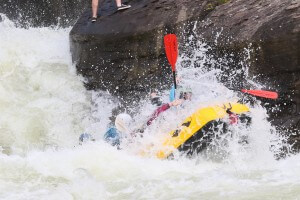
Rafting the Gauley River in West Virginia is possibly the most iconic river trip east of the Mississippi River. The river boasts big, forgiving Class V rapids set in an old, lush river gorge. This quintessential river is also the site of American Whitewater’s largest annual fundraiser called Gauley Fest. American Whitewater is a national nonprofit organization dedicated to funding river stewardship projects around the country. The festival draws rafters, kayakers and other river rats from all over the country to come together for several days of paddling whitewater and celebrating all that is river culture.
Travel and Camp
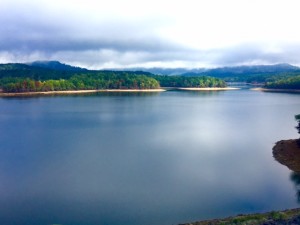 Gauley Fest has become an annual event for our whitewater addicted crew at Mountain Whitewater. The number of guides, friends and family participating has grown each of the last four years. A group of around 30 Mountain Whitewater folks traveled 1,494 miles from Fort Collins, CO to Summersville, WV to participate in the festivities in September of 2016. Our group made the 24 hour drive going straight through the night. The only major stop during the trip east was in Kansas City for some classic BBQ. The drive east is exhausting. It is taxing even with multiple drivers and rotating 3 to 5 hour shifts. The overnight driving effort is worth it because the drive is over in 24 hours. I was in the second car to arrive at camp early in the morning the day before the festival.
Gauley Fest has become an annual event for our whitewater addicted crew at Mountain Whitewater. The number of guides, friends and family participating has grown each of the last four years. A group of around 30 Mountain Whitewater folks traveled 1,494 miles from Fort Collins, CO to Summersville, WV to participate in the festivities in September of 2016. Our group made the 24 hour drive going straight through the night. The only major stop during the trip east was in Kansas City for some classic BBQ. The drive east is exhausting. It is taxing even with multiple drivers and rotating 3 to 5 hour shifts. The overnight driving effort is worth it because the drive is over in 24 hours. I was in the second car to arrive at camp early in the morning the day before the festival.
The Battle Run Campground is a nice facility with lots of amenities and it’s only a couple of minutes drive from the Gauley River put-in. The campground was the perfect spot for our large group. Our campsite was set in a nice wooded area at the top of a hill on the shore of Summerville Lake. The lake (actually a reservoir) is the source of the water that flows through the Gauley River. The different cars and trucks filled with the members of our group continued to arrive at the camp through out the morning. We were mostly set-up at camp by noon and we spent the rest of the day swimming and paddle boarding in the lake.
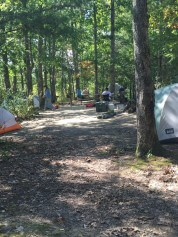
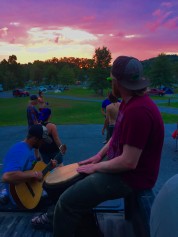
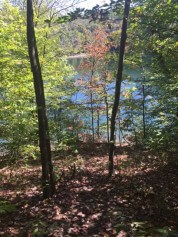
How the River Works
The Gauley River rafting season runs from early September to mid October each year. Water is released only four days per week, Friday to Monday. 7am to 1pm on weekdays, 6am to 3pm on weekends. The river festival always occurs on the third week in September. Paddler’s who are there during the festival are lucky to receive an extra hour of release each day that week. All of the river launches through the season and Gauley Fest are planned with this schedule in mind.
The plan for our crew was to be there to raft each day of releases during the week. We would get-up early each day, organize our equipment, run the shuttle and eat breakfast prior to launch. After the shuttle crew returned to camp, we would head down to the put-in. The Gauley River will see thousands of paddlers every day during the six week long rafting season. The week of Gauley Fest is even busier. As such, our crew would have to wait in a long line of vehicles to get to the launch site each morning. The waiting was not too bad though, as the scene in line unfolded to be a party of river guides gathering to celebrate the river. At the put-in we would load the coolers and safety equipment into the rafts, make sure we had enough paddles and launch our trip rafting the Gauley River.
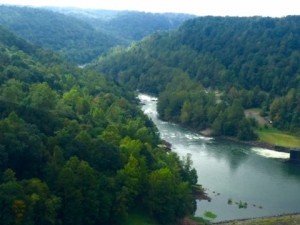
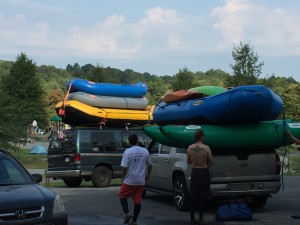
Rafting the Gauley River
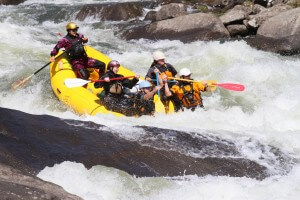 The Upper Gauley River is a 25 mile stretch of river that is divided into the upper and lower sections. Our crew spent all of our time on the Class IV-V upper section. The 10 mile Upper Gauley consists of steep gradient, large boulders and undercut rocks, technical rapids and high volume water. The Class V rapids on the run include Insignificant, Pillow Rock, Iron Ring, Lost Paddle and Sweet’s Falls. The pool-drop river has plenty of Class III and IV rapids in between the Class V’s as well. The microclimate inside the river gorge boasts fantastic scenery. Thick, green deciduous trees and shrubs dominate the landscape. It looks almost tropical in nature, especially when it rains. A stark contrast to what we see in Colorado.
The Upper Gauley River is a 25 mile stretch of river that is divided into the upper and lower sections. Our crew spent all of our time on the Class IV-V upper section. The 10 mile Upper Gauley consists of steep gradient, large boulders and undercut rocks, technical rapids and high volume water. The Class V rapids on the run include Insignificant, Pillow Rock, Iron Ring, Lost Paddle and Sweet’s Falls. The pool-drop river has plenty of Class III and IV rapids in between the Class V’s as well. The microclimate inside the river gorge boasts fantastic scenery. Thick, green deciduous trees and shrubs dominate the landscape. It looks almost tropical in nature, especially when it rains. A stark contrast to what we see in Colorado.
Our crew would spend half of each day rafting the Gauley River. Everyone would rotate paddling and guiding on different rafts each day. Some would kayak, some would go tandem in a paddle cat while others would ride in paddle rafts. The tradition while rafting the Gauley is to stop after Pillow Rock and Sweet’s Falls to watch others run the rapids. Both spots have large rocks in the river that paddler congregate on to watch the action. It was truly amazing to see how many different river folks were there to paddle and enjoy this unique river. Most of the runs from our group were successful, but we had our share of flips and swims. The water in the river is much warmer than the water in Colorado, so being in the river was refreshing. We were certainly not the only crew spending time in the water. Over and over again, we witnessed other flips, dumptrucks and swims. It is important to remember that the vast majority of the people on the river are experienced guides and paddlers. The amount of experienced river runners allows for a much safer situation. Most swimmers did not spend much time in the water, unless they wanted to. It is quite the scene and tons of fun.
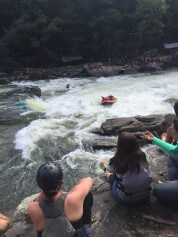
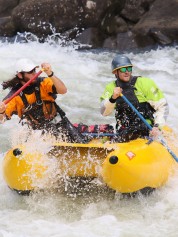
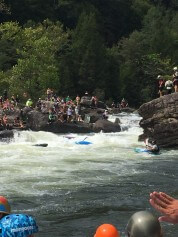
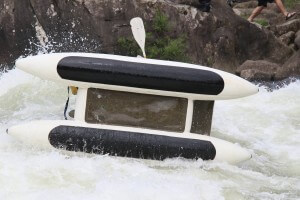
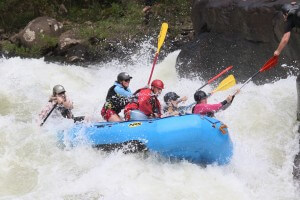
Gauley Fest
The River itself is what attracts most people to this event, but the festival is also an integral part of the experience. It is a place for all the river rats to gather after an extraordinary day on the river. The festival runs for three nights, each night being a little bigger and better than the previous. Whitewater manufacturers and stores set up vendor tents to sell and display their products. Local food trucks feed the crowd. Bands and DJs entertain. There are opportunities to purchase cheap gear, enter raffles and donate to American Whitewater. It is a great venue for sharing river stories and meeting like minded folks.
Overall, our trip east to raft the Gauley River was a huge success. It provided an unforgettable river experience and time spent with great friends. I can’t wait to go back next year!
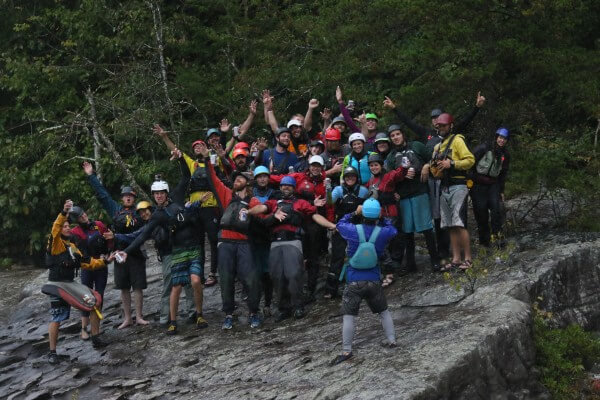
Poudre River Cleanup a Huge Success

Mountain Whitewater’s annual river cleanup had a great turnout and was a huge success!
by Cassi Ballard, June 2016
Mountain Whitewater’s annual Clean the Poudre 2016 had an incredible turnout of over 125 volunteers. The crew cleaned up over 4 cubic yards of trash and a full cubic yard of recycling. Everyone was well prepared and had the best attitudes we could ask for.
An appreciation event at Paddler’s Pub at Mountain Whitewater was held after the cleanup with food and drink provided by LaPorte Pizza, Odell’s, Serious Texas Bar-B-Q, Backcountry Deli, and Rio Grande Mexican Restaurant. Morning Fresh Dairy also brought 20 plus volunteers on their behalf and donated chocolate milk, lemonade, and yogurt for the appreciation event. So another thank you to these sponsors for supplying the hard working volunteers with free food and beer!
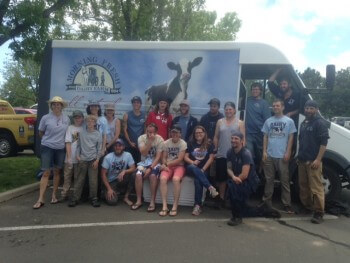 A huge thank you to Save the Poudre, American Rivers, and The City of Fort Collins Natural Areas Program for helping Mountain Whitewater sponsor this years cleanup.
A huge thank you to Save the Poudre, American Rivers, and The City of Fort Collins Natural Areas Program for helping Mountain Whitewater sponsor this years cleanup.
Everyone’s efforts and contributions to the river cleanup were and still are greatly appreciated. The positive impact on the river helps to shine light on the city of Fort Collins and all of its citizens and attractions.
If you’re looking for information about next years river cleanup give Mountain Whitewater a call and be sure to stay tuned for updates!
2015 Projected Flow for Poudre River Above Average
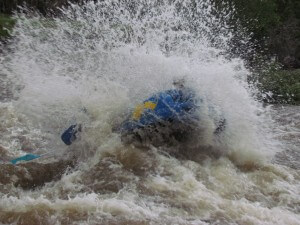 As of March 1, 2015 the Cache La Poudre River spring and summer flow is forecast to be at levels around 103% of average flows. This is according to the Colorado Water Supply Outlook Report issued by the US Department of Agriculture, Natural Resource Conservation Service (NRCS).
As of March 1, 2015 the Cache La Poudre River spring and summer flow is forecast to be at levels around 103% of average flows. This is according to the Colorado Water Supply Outlook Report issued by the US Department of Agriculture, Natural Resource Conservation Service (NRCS).
NRCS issues a monthly report from January to June every year that outlines snowpack levels, precipitation amounts, reservoir storage and stream flow forecasts for the different river basins in the State of Colorado. The Cache La Poudre River is a sub-basin of the larger South Platte River basin that covers most of northeast Colorado on the east side of the continental divide. Overall, the South Platte basin has seen 110% of median snowpack levels this past winter and has the highest on average stream flow forecasts for 2015 for each of its sub-basins (Cache La Poudre, Big Thompson, Boulder-St. Vrain, Clear Creek and Upper South Platte) compared to other basins in the State.
The streamflow forecast for the Cache La Poudre River comes as great news for recreation, as average to high snowpack levels translate to better water conditions. While there is still time for variations in the snowpack levels and ultimately spring and summer streamflows, above average numbers in March usually lead to very exciting peak levels in June and sustained water levels throughout the summer season. Another bit of good news from the report is that reservoir storage levels in the Cache La Poudre basin are also near or above average as well.
“We are very excited to see streamflow forecast near or above 100% of average for the Poudre River. Great water conditions are exciting for our staff and provide for an unforgettable rafting experience for our guests” says Ben Costello, Director of Fun for Mountain Whitewater.
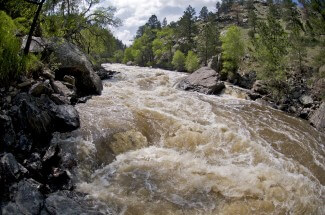 “We are looking forward to another fantastic season and cannot wait to start taking our guests down this very special river.”
“We are looking forward to another fantastic season and cannot wait to start taking our guests down this very special river.”
Whitewater rafting on Colorado’s only “Wild & Scenic River” is always a unique and memorable experience, but good water conditions make things even better. If a fast paced trip is what you seek, be sure to book your 2015 rafting trip in May or June for the most exciting water conditions. As long as we continue to see average snow fall amount in March and April (typically the best months for snow in Colorado), conditions for rafting on the Cache La Poudre River will be fantastic for the entire 2015 river season.
Follow this link to the Basin Outlook Report to read the entire report for yourself or to check on forecast conditions around the rest of our beautiful state.
Mountain Whitewater Finds Success with New Booking Engine
For the summer 2014 whitewater rafting season, Mountain Whitewater was in need of finding a new reservation platform. Our old system worked, but was outdated, not intuitive for users and did not provide the kind of support that we would like. There are a multitude of different reservation software platforms available for tour operators today, but not all work in a way that is convenient for both guests and staff. Our goal was to find a system that allowed our guests to book in an easier, more streamlined way that looked professional and kept feel or our website. After researching different platforms, we found Rezdy and could not be happier.
Booking your adventure on our website is now a breeze. There are less steps to go through for guests, whether booking online or over the phone with our professional staff, which means less time booking your experience and more time enjoying your vacation. Rezdy has also benefited the business by giving our staff more time to focus on providing great customer service that is expected by our guests because they spend less time clicking through screens in the booking software. Rezdy was easy to implement, is easy to use and provides very high quality support.
Thanks to Rezdy for building and maintaining such a useful booking tool. We are excited to provide a worry free way for our guests to book the experience of a lifetime. For more information check this link to our Rezdy case study.
Tales from the Wild-Crow Not the Best Meal
According to the Knight-Ridder News Service, the inscription on the metal bands used by the U.S. Department of the Interior to tag migratory birds has been changed. The bands used to bear the address of the Washington Biological Survey, abbreviated Wash. Biol. Surv. until the agency received the following letter from an Arkansas camper:
Dear Sirs: While camping last week I shot one of your birds. I think it was a crow. I followed the cooking instructions on the leg tag and I want to tell you it was Horrible! The bands are now marked Fish and Wildlife Service. These should illustrate why it is important to reacquaint people with the wilderness.
Equally Challenged with Special Guests
Friday evening music series at Mountain Whitewater
Another great night of music at the Paddler’s Pub was had by all on Friday! The band Equally Challenged performed live with some help of some special guests from the Honey Gitters, Bourbon Toothpaste and the Holler!.
Concert goers enjoyed the music while playing volleyball, drinking local Colorado beers and enjoying the fantastic view of the foothills at Mountain Whitewater.
It was a great night for the members of the Fort Collins community to get together and create some happier moments during these tougher times.
Members of the community shared beers and stories about the High Park Fire. All firefighters enjoyed their first beer for free as a thank you! They are working extremely hard to protect the Poudre Canyon which many of us call home.
Thanks to all who came out to join us! We look forward to next Friday when The Seers will join us for another night of great music! (from 5-8pm)



